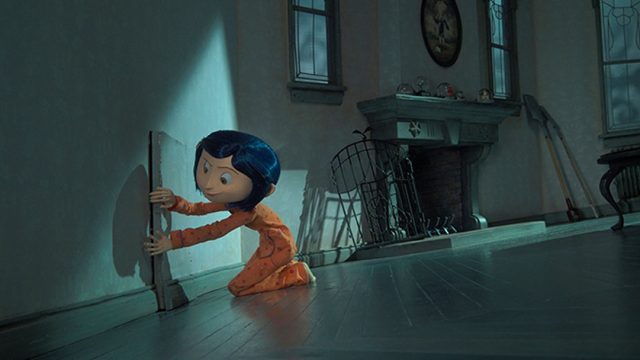In Seanan McGuire’s excellent fantasy novel Every Heart A Doorway – about a boarding school for children who disappeared into and returned from fairy tale adventures to disbelieving family – one character explains the alignments of the known fantasy realms as such: “Here in the so-called ‘real world,’ you have north, south, east and west, right? Those don’t work for most of the portal worlds we’ve been able to catalog. So we use other words. Nonsense, Logic, Wickedness and Virtue. There are smaller subdirections, little branches that may or may not go anywhere, but those four are the big ones.” For example, The Dreaming from Sandman would be high-Nonsense, null-Virtue/Wickedness: a completely pliable, lawless reality. The Land of Oz is mid-Nonsense, mid-Virtue, featuring some stable ground rules and a generally harmonious existence among its residents.
The world Coraline finds behind her door falls into one of those subdirections, a high degree of Nonsense that hides something Wicked. To put it another way, it’s a trap. Laced with sewing and arachnid imagery, the Other world is spun as a freewheeling playground for Coraline, where her parents and the new neighbors of the complex they’ve moved into exist solely to entertain her. However, it’s really a web, and once the ruler of the realm, the Other Mother, is able to bind Coraline (by sewing buttons into her eyes) she will feast on her energy, killing her.
Neil Gaiman is well-versed in fairy tales and fantasy, so while Coraline draws from a lot of sources (there’s more than a little Alice in Wonderland here), one can trace a direct line to Ray Bradbury’s Halloween classic Something Wicked This Way Comes. both draw a lot of unease from carnival/circus imagery (many of Coraline’s neighbors are former performers), both involve traps that drain life force (in Something Wicked, it’s the mystical ferris wheel), and both find tranquility and danger in small American towns. The unnamed setting in Coraline is somewhere in the Pacific northwest, and if the small Illinois town in Something Wicked feels like a hidden train stop in the middle of the country, Coraline’s home feels like the end of the line. It’s a place of loners, old eccentrics and ancient forces, long hidden and whittling away the hours until new blood drips in. (Coraline encounters the ghosts of three children while in the Other world, and it’s telling that most of them seem to have lived in the distant past) This was well before Portland had gained national attention as a hip place and just as Microsoft was starting to colonize Seattle.
The animation by Laika Entertainment is extraordinary, and while it isn’t the film that made them a household name it certainly put them on the film industry’s radar. (Their only other feature as a company was Tim Burton’s The Corpse Bride) Still, it’s not QUITE a Laika movie. The story belongs to Gaiman (and, frankly, is more structurally sound that just about everything Laika made after), and Henry Sellick’s nervous, fidgety style echoes through every character. (Consider Wylie, an invention of the film who never, ever stops moving, even if only to constantly shift his weight) The design is a softer than what would become the house style, which only really comes through when the Other Mother becomes a little more herself – sharp angles and spindly limbs.

